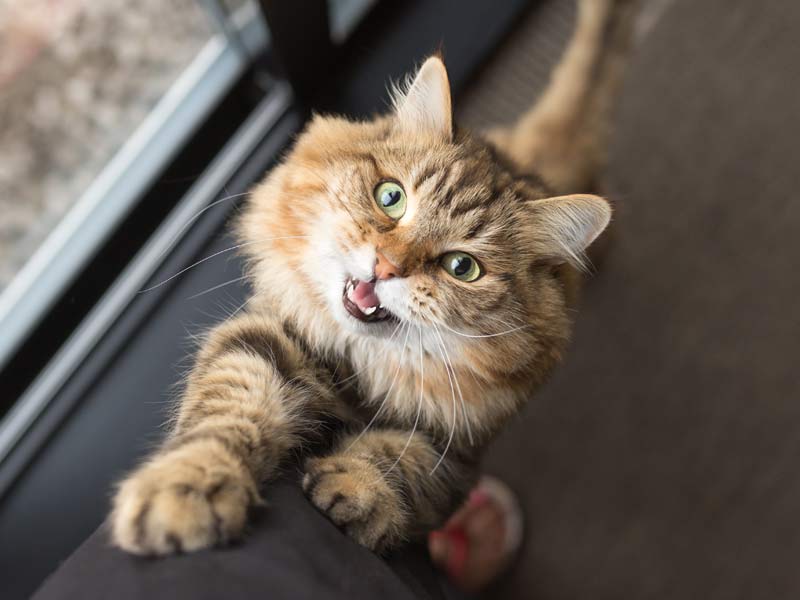Learn the reasons why most cats don’t like water
Not everyone, but the vast majority of cats don’t like water. Cats that have had positive experiences around and in the water, especially during their key socialization period (between 3 and 8 weeks of life) have a good relationship with it.
In addition, some specific breeds love water! It is important to treat your cat without any expectations and understand how he will deal with every thing that is presented to him.
Many cats have evolved to dislike water.
It is believed that cats were domesticated 9,500 years ago in the Middle East. They grew up in the arid desert climate and were not exposed to rivers, lakes and rain. In this way, cats evolved by avoiding contact with water.
Even street cats often seek shelter from rain and storms. Hiding from water has become a natural instinct for today’s cats.
This is not the rule for all races, since some of them like to be in the water due to their own evolutionary process. Turkish Van and Turkish Angora, for example, are known for their love of water and swimming skills.
They have adapted to their climate in the Lake Van region of Turkey, diving their hair in the summer to swim and fish. Other breeds that are more likely to enjoy the water are Bengal, Maine Coon and American Bobtail.
Cats are sensitive to perfumes
Cats have an extraordinary sense of smell, 14 times more sensitive than ours. The strong aromas associated with shampoos and conditioners can contribute to the cats’ aversion to water and bathing. Some have also speculated that their cat may not like the smell of chemical components in tap water.
Cats love to be clean and warm…
Cats are meticulous in their natural cleansing and spend much of their time taking care of themselves, keeping the skin clean, untangled and well conditioned. In addition, they also maintain a higher body temperature. And cleansing helps maintain and regulate body temperature.
When a cat’s coat gets soaked, it becomes very heavy, and returning to the dry and heated state is difficult and time consuming. Wet coat can also make the cat feel slow and not as agile as usual. Therefore, it has the uncomfortable feeling of not being able to get out of a situation quickly.

Water Aversion
The experience of many cats with water is not positive so it is understandable that many cats do not like water. For example, getting stuck in a homeless shower, being sprayed with water, and forced baths. That is why it is so important to socialize this contact when they are still puppies.
Cats need baths?
As mentioned, cats do a wonderful job of keeping themselves clean. They can spend up to 40% of the day cleaning themselves, so you may never need to bathe your cat.
Cats may need a bath due to skin problems. While elderly, arthritic and overweight cats may have difficulty reaching certain parts of the body. In addition, a bath may also be necessary if the cat rolls into something sticky or stinky.
How to make my cat like bathing?
Before bathing
First, get the cat used to the space that will be given the bath. Then, try to familiarize the cat with the bath weeks before bathing. Put your cat in the bath without water and put toys and some snacks so that he makes positive associations with the place.
Once your cat is comfortable playing and eating snacks in the sink or bathtub, fill with some warm water and spread toys so that he can have fun with it. Encourage your cat to play with the toys and reinforce with compliments and snacks when he does.
When you finally go for the bath, have everything ready and handy. This includes shampoo for cats, special snacks and toys that your cat loves, hot towels, a glass to pour water on your cat and a non-slip surface such as a bath mat or a towel to put in the sink or bathtub for your cat to stand on.
Create a calm environment. Close the door and keep noise to a minimum. Stay calm and speak softly. If your shower or tap is too strong, wash your cat with cups of water. If you are stressed, your cat will be too! Staying calm is very important.
During the bath
Use minimal restraint and positive distractions. Avoid scruffing and holding your cat down. Instead, be gentle, observe your cat’s body language and provide positive distractions, such as a special scattered treat and/or a wand toy.
Be very careful not to throw water on your face or wet your ears or eyes. Avoid washing your whiskers. Cat whiskers are the place where many of the cat’s touch receptors are located and it is natural that they hate receiving water, food and dirt in these receptors. In addition, it is important to rinse the shampoo well to avoid skin irritations.
After the bath
First, gently lift your cat out of the water and immediately wrap it in a warm, dry towel to dry. Or, if your cat doesn’t like to be carried, let the water drain and towel dry while still in the tub.
Your cat can finish drying naturally in a few hours and in the meantime, they should be kept warm and away from draughts. Finally, end this time of bathing with affection, a play session and your cat’s favorite treat!
